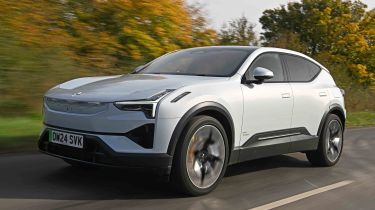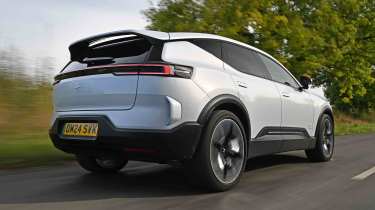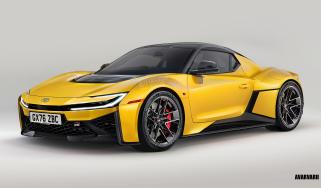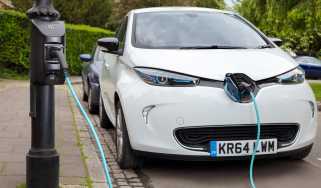Polestar 3 review
Sleek looks define the brand’s largest model, but the technology of the Polestar 3 is unnecessarily fiddly

Is the Polestar 3 a good car?
The Polestar 3 is the company’s largest car to date, and it has electric rivals from the big German manufacturers in its sights. It aims to take on the Audi Q6 and Q8 e-trons plus the BMW iX and Mercedes EQE SUV by being big on tech, performance and battery size.
Unlike many of those rivals, Polestar has kept the roof of its car relatively low; it’s roughly 80mm below the BMW’s, for example. Not only does that give the Polestar 3 a sleek and dramatic presence on the road, it also makes use of slick aerodynamic aids, such as the front spoiler at the leading edge of the bonnet. As a result, it enables this near five-metre-long, two-metre-wide SUV to return a slippery drag coefficient of 0.29Cd.
When it comes to space, range, charging speed and performance, everything looks great on paper, but in the real world, the Polestar 3 doesn’t quite deliver on all of those fronts. However, the well honed chassis means it’s better to drive than its substantial size would lead you to believe.
| Key specs | |
| Fuel type | Electric |
| Body style | Five-door, five seat SUV |
| Powertrain | 107kWh battery, 1x e-motor, rear-wheel drive 107kWh battery, 2x e-motors, four-wheel drive |
| Safety | Not yet tested by Euro NCAP |
| Warranty | Three years/60,000 miles |
How much does the Polestar 3 cost?
Given that it’s a premium electric SUV, prices for the Polestar 3 are on the high side. It starts from around £70,000 for the Long Range variant, while the Long Range Dual Motor version adds around £6,000 to the price. At the top of the tree sits the Performance model, which does what it says, and bumps up the power of the Dual Motor model for an extra £5,500.
More reviews
Car group tests
In-depth reviews
These three variants offer different power outputs, ranging from 295bhp for the Long Range model, through 483bhp for the Dual Motor version, and then 510bhp for the Performance variant. All three come with just one battery size, which has 107kWh of usable capacity.
Prices are high, but the Polestar 3 is very well equipped even in entry-level form. There are 20-inch alloy wheels, Brembo brakes, LED lights with active main beam, auto lights and wipers, electrically heated frameless door mirrors, a powered tailgate, three-zone climate control, heated front seats, a 14.5-inch central display with a Google operating system, built-in apps and 5G connectivity, plus a vast suite of safety systems.
Electric motors, performance & drive
Even the least powerful version of the Polestar 3 has decent performance, while the Dual Motor versions have sub-five-second 0-62mph times. But there’s more to these cars than simply straight-line performance, because while the Polestar 3 is a big car that weighs in at two-and-a-half tonnes, it delivers reasonably tidy handling, with decent body control and quick steering. Cruising comfort is the strongest part of the car’s driving package, though. Read more about the Polestar 3's electric motors, performance and drive…
Range, charging & running costs
With a 111kWh battery (107kWh of which is usable), we’d expect the Polestar 3 to deliver a long range. The official figures don’t disappoint, with a maximum range of 438 miles quoted, but when we tested the car, poor efficiency meant that we could only extract around 260 miles from the battery. There’s a heat pump as standard that will help maintain range in cold weather, while rapid charging will take the battery from 10-80 per cent capacity in half an hour. Read more about the Polestar 3's range, charging and running costs…
Interior, design & technology
The Polestar 3 features design cues first seen on the Polestar 2, so there’s a simple, minimalist layout with very few buttons, while the centre console is dominated by a vast portrait-style touchscreen. The low button count isn’t quite at Tesla levels, but most functions are controlled via the main screen. There’s gloss black plastic and gold highlights in places - a Polestar trademark - while cabin quality is up there with the brand’s premium rivals. Read more about the Polestar 3's interior, design and technology…
Boot space, comfort & practicality
While the Polestar 3 has a crossover-style shape, its sheer size means that there’s plenty of room inside, especially for back-seat passengers. Although it shares a platform with the seven-seat Volvo EX90, the Polestar 3 is a five-seater, but the back seats are set far back, so there’s lots of legroom, and headroom is great, although a little limited by the shape of the panoramic roof. However, boot space is a bit disappointing, with the high-set floor and low roof combining to limit space when compared with the Polestar 3’s rivals. Read more about the Polestar 3's boot space, comfort and practicality…
Reliability & safety
While Euro NCAP has yet to put the Polestar 3 through its paces, the fact it uses a cutting-edge platform that’s shared with sister brand Volvo means it should be a top performer in the safety organisation’s stringent test regime. There are 10 airbags on board, strong side-impact beams and whiplash-mitigating front-seat headrests, while active safety uses radar and camera systems to help keep the Polestar 3 and its occupants safe. Read more about the Polestar 3's reliability and safety…
Polestar 3 alternatives
The large SUV sector is awash with electric options, so the Polestar 3 will have to fight for sales. It goes up against the likes of the BMW iX, Mercedes EQE SUV and even the Volvo EX90, a car that is based on the same basic platform. It’s arguable that the Polestar’s relatively distinctive shape will help it to draw buyers in.
Frequently Asked Questions
There’s a three-year/60,000-mile warranty for the whole car, while the drive battery comes with eight years or 100,000 miles of cover.









